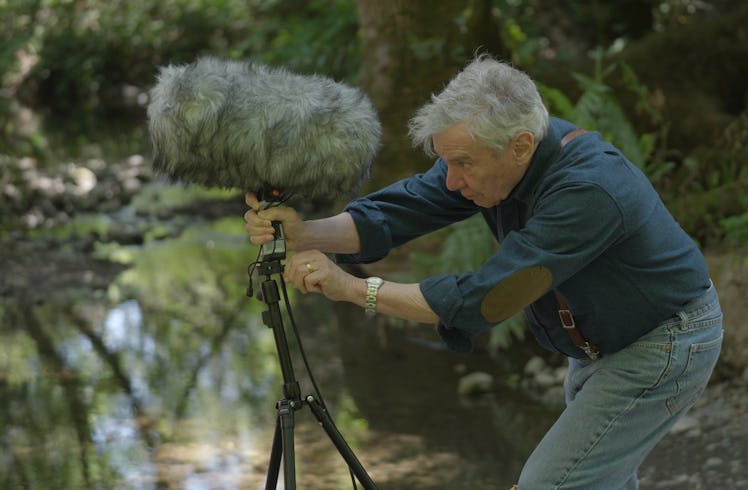Bernie Krause Harnesses the Sounds of a Planet in Danger

For our annual “The Originals” issue, we asked creatives—pioneers in the fields of art, design, fashion, comedy, activism, and more—to share their insights on staying true to themselves. Read all of this year’s interviews here.
Your acoustic work The Great Animal Orchestra, which was first shown in 2016 at the Fondation Cartier Pour l’Art Contemporain, is coming to the Peabody Essex Museum in Salem, Massachusetts, in November. Drawing on more than 5,000 hours of sounds that you collected over the course of 50 years, you culled material from different habitats to create this piece. Why do you think a museum founded in 1799 wants to show this very contemporary work?
Since its first Paris showing, this exhibition has been experienced by over a million visitors in Milan, London, Shanghai, and Seoul. That kind of attendance gets the attention of museum curators.
What can people expect?
The setting, with requirements specified by the Fondation Cartier—the owners of the piece—is a rectangular room, acoustically treated and sonically isolated from other areas. It’s designed to be a stand-alone theatrical space. The entire show sequence runs a little over 90 minutes, and the only visuals one sees are streaming graphic illustrations of the soundscapes, called spectrograms. We purposely don’t show graphics of animals or bucolic scenes, because they’re distracting and take away from the power of the soundscapes.
What’s the most vital takeaway?
The visitor hears bioacoustic representations of seven different types of habitats, marine and terrestrial, all of which are now under stress and threat of becoming altogether silent—functionally extinct—as a consequence of global warming and human endeavors such as logging, mining, unsustainable agriculture, and land development. The message is unassailable.
Art-world types are used to video pieces, but less so aural ones.
We’re a visual culture, and unused to having sight follow sound. With The Great Animal Orchestra, we flip that concept on its head. The biophonies—the collective sound produced by all vocal organisms in a given habitat—become the driving force. While a picture may be worth a thousand words, a soundscape is worth a thousand pictures.
The extreme weather of 2021 seems like a warning, but you have had personal experience with it.
In early October 2017, my wife, Kat, and I lost everything in the wildfires that destroyed large areas of Northern California. All of my detailed field journals going back half a century. Slides and photos of work in the field. Reference books. Nearly 70 years of historic correspondence. As we raced toward the car, a fire tornado seethed with a voice of rage, a sound I’d never heard before and hope never to hear again—the combined sucking roar of wind and blistering heat—while the propane tanks of neighbors exploded all around us. That sound haunts us to this day; I rarely make it through a night without awakening to frightful sonic nightmares. It’s a reminder that natural forces will always triumph in the end.
Bernie Krause, 2021 © Masha Karpoukhina for Fondation Cartier pour l’art contemporain.
In an earlier career, you did sound and scoring for master filmmakers like Francis Ford Coppola. How did that influence your art?
I personally found the studio music scene I was involved in too limiting and boring. I needed to be outdoors, hiking in the woods. Studio work just made me more intent on escaping, in order to feel more human and connected to the living world. That meant finding another outlet. I’ve been saddled with a terrible case of ADHD since I was a kid, and listening to those biophonies in wild places was the only nondrug activity that helped mitigate it.
What was the wildest situation you found yourself in to gather animal sounds?
Late one night in 1990, with my colleague and friend Ruth Happel, I was hiking through an Amazon forest. At one point, we picked up the unmistakable scent of a jaguar that had been following us. We were alone in the forest, several kilometers from camp. We never saw or heard the animal, but we knew it was close by. At times, the scent was pretty impressive. For some reason, neither of us felt that we were in immediate danger.
Uh-oh. You found out otherwise?
Around midnight, I sat down alone beside the trail and began to record—only then did I hear the cat’s low snarl in my headphones. My heart skipped several beats, but I remained very still. I managed to record some low growls and breaths. Then, as suddenly as it had appeared, the cat moved silently into the underbrush, leaving only the throbbing pulse of frogs and insects in the night. By the way, visitors to the museum can hear that very same jaguar, because it is featured in the museum soundscape.
What you do is complicated to sum up succinctly. When you meet someone at a party, how do you describe your job?
I generally tell folks who ask that I’m an accountant.